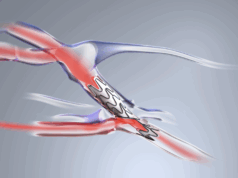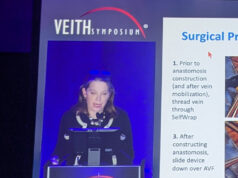 Led by Hyangkyoung Kim (Ewha Womans University Medical Center, Seoul, South Korea) and featuring corresponding author Hoon Suk Park (The Catholic University of Korea School of Medicine, Seoul, South Korea), a study published in Hemodialysis International has found that arteriovenous fistulas (AVFs) are a safer and more effective option for end-stage kidney disease patients aged ≥ 65 years than arteriovenous grafts (AVGs).
Led by Hyangkyoung Kim (Ewha Womans University Medical Center, Seoul, South Korea) and featuring corresponding author Hoon Suk Park (The Catholic University of Korea School of Medicine, Seoul, South Korea), a study published in Hemodialysis International has found that arteriovenous fistulas (AVFs) are a safer and more effective option for end-stage kidney disease patients aged ≥ 65 years than arteriovenous grafts (AVGs).
The study sought to establish the outcomes from the two procedures in this specific population in response to the “fistula first” initiative, which they describe as “controversial in patients ≥ 65 years”. This population, they point out, is one that makes up nearly half of those who initiate haemodialysis.
Previous studies have raised questions about the advantages of AVFs relative to other haemodialysis access modalities in older populations. These include a 2013 study by Ranil N DeSilva (Beth Israel Deaconess Medical Center, Boston, USA) et al, which suggested that “a competing strategy of AVG” should be considered for elderly patients, and which also found no statistically significant advantage on mortality for AVF over AVG.
Kim and Park set about expanding the evidence base on the issue with a retrospective review of data from South Korea’s National Health Insurance Service relating to 41,989 patients aged ≥ 65 years. The patients’ characteristics and outcomes, encompassing “vascular access patencies, risk factors associated with patencies, and patient survival between AVF and AVG”, were then compared.
Among those patients, 28,467 received a permanent AV access with an AVF while 13,522 received an AVG. The AVF group demonstrated superior primary, primary assisted and secondary patencies (all p<0.001), while they also showed better rates of survival (p<0.001). A Cox regression analysis found that AVG was a risk factor relative to AVF for all-cause mortality (adjusted hazard ratio [HR]: 1.307; 95% confidence interval [CI]: 1.272–1.343; p<0.001) as well as primary patency (adjusted HR: 1.745; 95% CI: 1.701–1.790; p<0.001). Similarly, it was also a risk factor on primary-assisted patency (adjusted HR: 2.163; 95% CI: 2.095–2.233; p<0.001) and secondary patency (adjusted HR: 3.718; 95% CI: 3.533–3.913; p<0.001).
The authors of the study state clearly that their results point to AVF as a markedly superior option for permanent access for haemodialysis, even in those aged ≥ 65 years. It should be “strongly considered” for those in this age group with ESKD, argue Kim and Park, who suggest finally that “the age limit for AVF creation in ESKD patients should be adjusted upwards”.











